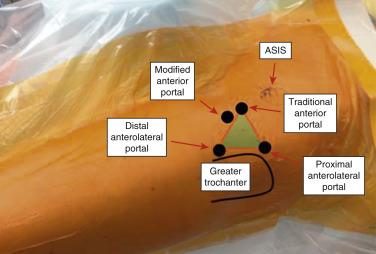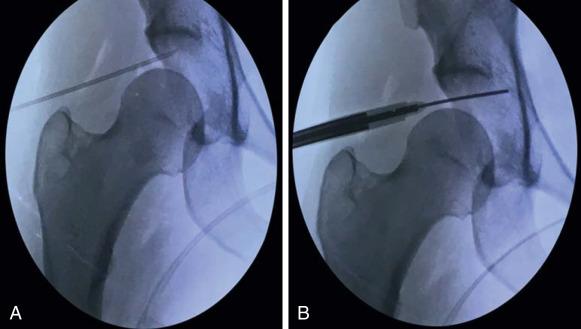Physical Address
304 North Cardinal St.
Dorchester Center, MA 02124
Hip arthroscopy is a commonly performed procedure used to treat intra- and extraarticular disorders of the hip. Since 2010, there has been a significant rise in the number of hip arthroscopies performed. This is because of a multitude of factors: a better understanding of complexities of intra- and extraarticular hip disease, significant improvements in surgical instrumentation and techniques, and an overall increase in the number of surgeons trained with a focus in hip preservation strategies. However, hip arthroscopy is associated with a steep and well-documented learning curve. , As the sheer volume of hip arthroscopies performed each year has increased, inevitably so too has the number of complications. The rate of complications associated with modern hip arthroscopy techniques is generally accepted to be less than 1.5%; however, a recent systematic review characterized the incidence between 0.5% and 8%. Somewhat unique to hip arthroscopy, potential complications can be wide ranging, from access-associated neurovascular injury to iatrogenic chondrolabral injury, postoperative fracture or instability, femoral head avascular necrosis, or intra- and postoperative cardiopulmonary compromise secondary to fluid extravasation. The goal of this chapter is to present the most common hip arthroscopy complications and strategies to prevent and treat those complications should they occur.
Arthroscopic portals must be positioned around the hip to gain access for instrumentation. Most commonly, in modern hip arthroscopy techniques two or three portals are used ( Fig. 42.1 ). When performing both central and peripheral compartment work, the authors’ preferred technique uses three portals (proximal anterolateral (PALA), modified anterior (MA), and distal anterolateral, which are established based on the bony landmarks of the greater trochanter and the anterior superior iliac spine (ASIS). The PALA portal is established first under fluoroscopic guidance ( Fig. 42.2 ). Special attention is paid to maintaining the bevel of the spinal needle angled toward the convexity of the femoral head so as to not cause iatrogenic injury to the cartilage and to remain distal to the labrum ( Fig. 42.2A ). Once an air-arthrogram is confirmed, a nitinol wire is advanced through the needle. If the PALA portal is established in the correct position, the wire will remain straight in line with the portal trajectory ( Fig. 42.2B ). If the access point is too far anterior or posterior, the nitinol wire will bend around the acetabulum and complicate access. Also, the surgeon must confirm that the nitinol wire is not advanced too far while inserting the cannulated trochar system under fluoroscopic guidance to minimize breakage of the guidewire. Broken instrumentation accounts for 0.5% of all reported complications, most of which can be avoided with careful attention. , Once the PALA portal is established, the MA portal is established under direct visualization and fluoroscopic guidance. A straight line from the ASIS to the patella is drawn to indicate a medial border that should not be violated during instrumentation because the femoral neurovascular bundle lies directly medial to this line. Thankfully, major neurovascular injury is a rare complication because this would be potentially devastating. The medial border line must be respected during instrumentation to ensure this complication does not occur. More commonly, the lateral femoral cutaneous nerve (LFCN) can be injured both from direct injury during portal creation and from neuropraxic stretch secondary to fluid extravasation. The anatomic course of the LFCN is quite variable; however, it is most at risk with establishment of the traditional anterior portal. For this reason, the MA portal is used by the authors to decrease the risk of LFCN neuropraxia. When making this portal, only a minimal skin incision is established with the scalpel, and a curved hemostat is used to bluntly develop the plane required down to the level of the capsule. Nakano et al. found LFCN neuropraxia to be the most common of all complications associated with hip arthroscopy; it occurred in 0.3% of their 36,761 reviewed cases and constituted 7.8% of all reported complications. Fortunately, in most cases we have found LFCN neuropraxia to resolve within 6 weeks of the index procedure. Rarely, postoperative adhesions and scar tissue may entrap the LFCN branches during healing and require neurolysis. We have found that keeping the incision as small as possible, closing the MA portal skin only with nonabsorbable sutures, and avoiding the use of deep sutures can help to minimize this risk. This also has anecdotally decreased the risk of superficial wound infections and the development of deep absorbable suture reactions. Wound infections constitute anywhere from 1% to 5.7% of all complications according to various sources; however, we recognize the reporting bias of what may constitute a true superficial wound infection versus a suture reaction. , , Regardless, our practice is to minimize the size of portal incisions and close the wounds only with nonabsorbable sutures that are removed in clinic approximately 2 weeks postoperatively.


Become a Clinical Tree membership for Full access and enjoy Unlimited articles
If you are a member. Log in here